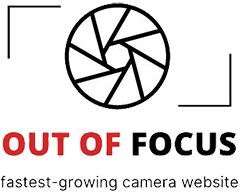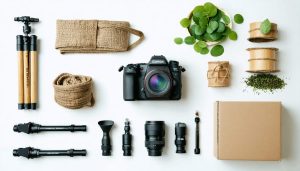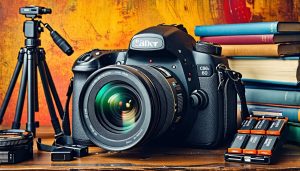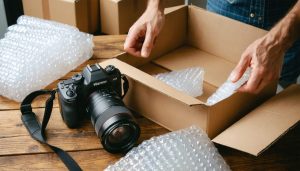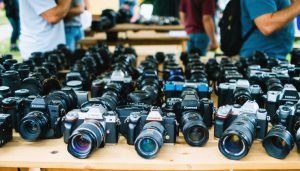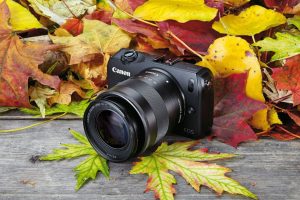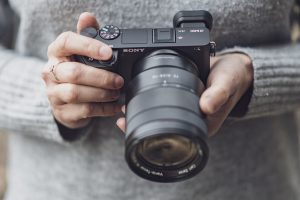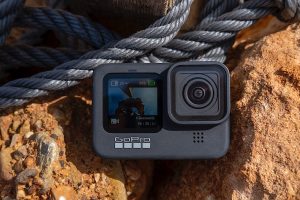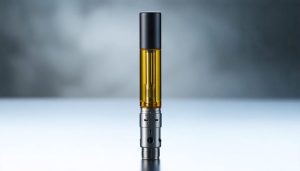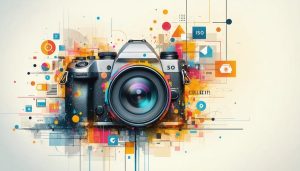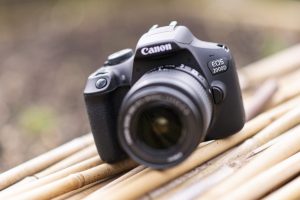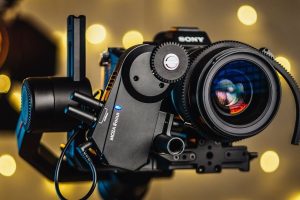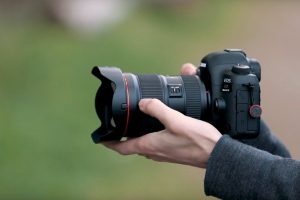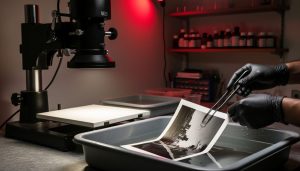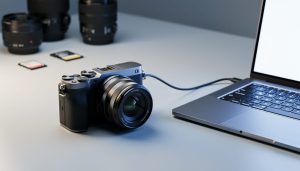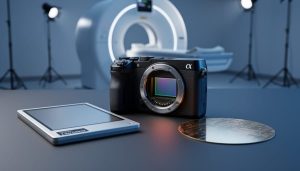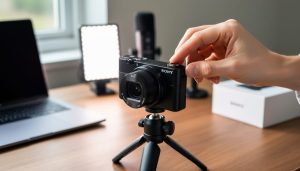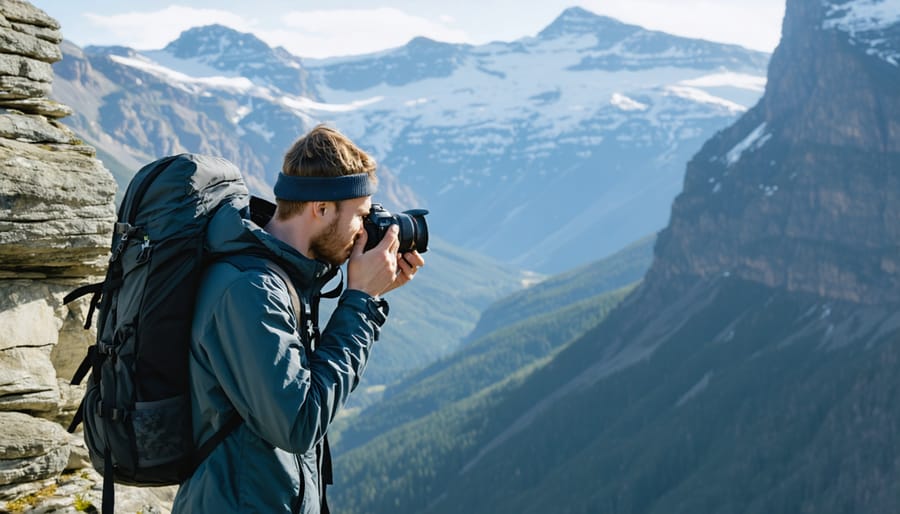
Picture this: Your $5,000 camera slips from your grasp during a mountain shoot, tumbling down the rocky slope. Without insurance, that heart-stopping moment could mean both a creative and financial disaster. Professional photography gear represents a significant investment, often totaling tens of thousands of dollars, yet many photographers overlook the crucial step of protecting their equipment.
Proper insurance coverage isn’t just a safety net—it’s an essential business tool for professionals and a smart safeguard for serious enthusiasts. Whether you’re shooting weddings in unpredictable weather, traveling internationally with your gear, or simply working in dynamic environments, your equipment faces constant risks: theft, damage, accidents, and natural disasters.
What many photographers don’t realize is that standard homeowner’s or renter’s insurance policies typically offer limited coverage for professional equipment, often with high deductibles and strict limitations on business use. Professional photography insurance fills these critical gaps, providing comprehensive protection tailored specifically to photographers’ unique needs.
This guide will help you understand your insurance options, identify the right coverage for your situation, and protect your valuable investment—ensuring you can focus on creating amazing images without worrying about the “what-ifs” that could derail your photography journey.
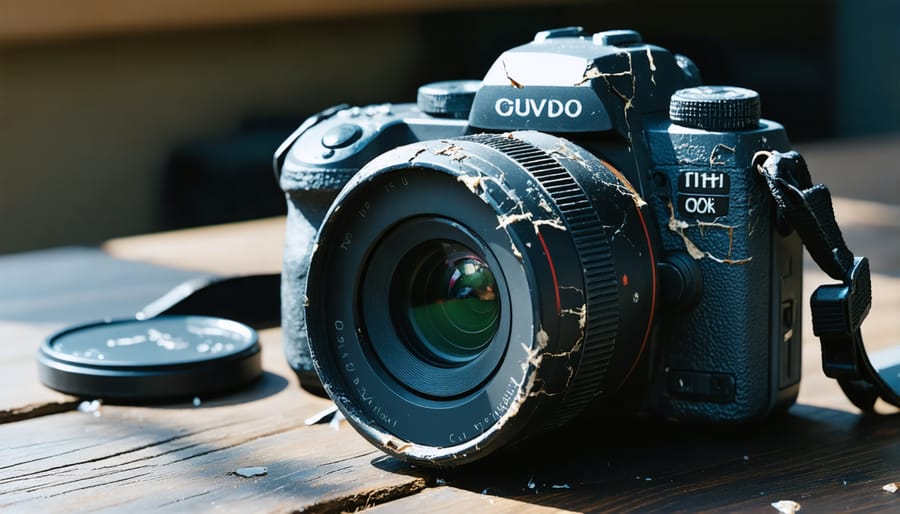
Why Standard Homeowners Insurance Isn’t Enough
Coverage Gaps and Limitations
While photo equipment insurance provides essential protection, it’s crucial to understand what your policy might not cover. Most standard policies have specific exclusions and limitations that photographers should be aware of. For instance, many policies don’t cover normal wear and tear, gradual deterioration, or mechanical failures that aren’t caused by accidents.
Another common gap is coverage for equipment left unattended in vehicles or public spaces. Some policies may deny claims if your gear wasn’t properly secured or if you can’t prove forced entry in case of theft. Additionally, many policies have restrictions on international coverage, typically limiting protection to specific geographical regions or requiring additional riders for worldwide coverage.
Professional photographers should note that standard policies might not cover equipment used for commercial purposes. You’ll need specialized professional coverage for business use. Data loss, including lost images or corrupted memory cards, is usually excluded from physical damage coverage.
Be mindful of policy sublimits, which may cap replacement values for individual items below their actual worth, particularly for high-end cameras and lenses. Always read the fine print and discuss any concerns with your insurance provider to ensure adequate protection.
Professional vs. Personal Use
The distinction between professional and personal use significantly impacts your photography equipment insurance coverage. Professional photographers typically need more comprehensive policies as they rely on their gear for income. These policies often include coverage for business-related risks like equipment rental, liability protection, and income loss due to damaged gear.
Personal-use policies, designed for hobbyists and enthusiasts, generally offer more basic coverage at lower premiums. However, they might exclude commercial activities entirely. If you occasionally sell prints or shoot events for friends, you’ll need to clarify with your insurer whether these activities constitute professional use.
Be aware that using personal insurance for professional work could void your coverage. Many photographers start as hobbyists and gradually transition to paid work – this is precisely when you should review and potentially upgrade your coverage. Some insurers offer hybrid policies for semi-professionals, providing a middle ground between full commercial and personal coverage.
The key is being honest about how you use your equipment when applying for insurance. Misrepresenting your usage could result in denied claims when you need coverage most.
Specialized Photography Insurance Options
Personal Articles Floater
Personal Articles Floater (PAF) coverage is a popular insurance option that specifically caters to photographers who want comprehensive protection for their equipment. This type of coverage extends beyond your standard homeowners or renters insurance, offering worldwide protection for your gear whether you’re shooting in your backyard or on assignment overseas.
One of the key benefits of PAF coverage is that it typically covers accidents, theft, and damage with fewer exclusions than standard policies. For instance, if you accidentally drop your camera in water during a beach shoot or your lens gets damaged during transport, PAF insurance usually has you covered. Most policies also protect against mysterious disappearance – a feature particularly valuable for photographers who work in various locations.
PAF policies generally offer replacement cost coverage rather than actual cash value, meaning you’ll receive enough to replace your equipment with new items of similar quality, without depreciation deductions. This is crucial considering how quickly photography equipment can depreciate in value.
Another significant advantage is that PAF coverage typically has no or very low deductibles compared to standard insurance policies. Many photographers appreciate that claims under PAF coverage don’t affect their homeowners insurance premiums or claims history, keeping their primary insurance rates stable even if they need to file a claim for their photography equipment.
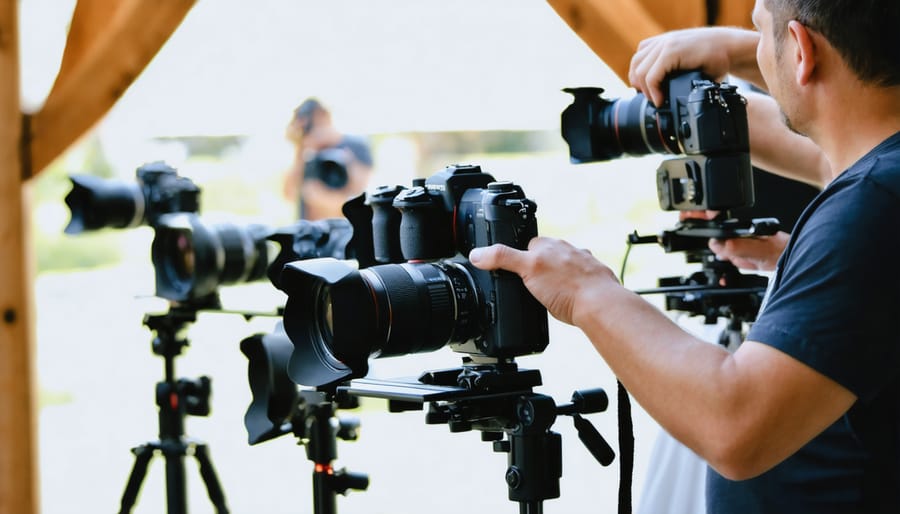
Professional Photography Insurance
For professional photographers, standard personal insurance policies often fall short of providing adequate coverage for their business needs. Professional photography insurance packages typically combine several types of coverage to protect both your professional wedding photography equipment and your business operations.
Most photography business insurance packages include general liability coverage, which protects you against third-party claims for bodily injury or property damage that might occur during photo shoots. Equipment coverage for professionals usually offers higher limits and broader protection than personal policies, including worldwide coverage and protection against theft, damage, and loss while on location.
Professional insurance also typically includes business interruption coverage, ensuring you can recover lost income if damaged equipment prevents you from fulfilling client commitments. Many policies offer additional protection for rented equipment, portfolio coverage, and even drone insurance for aerial photography.
When selecting professional insurance, consider adding errors and omissions (E&O) coverage, which protects against claims related to professional mistakes or oversights. This is particularly important for wedding and event photographers where the stakes are high and moments can’t be recreated.
Most insurers specializing in photography business coverage offer customizable packages, allowing you to select the specific protections that match your business needs and budget. Annual premiums typically range from $500 to $2,500, depending on coverage levels and the value of your equipment.
Rental Equipment Coverage
When renting professional camera gear for specific projects or events, you’ll need to consider insurance coverage that differs from your regular equipment protection. Most rental houses offer their own insurance options, typically charging between 10-15% of the rental fee for basic coverage. However, it’s essential to read the fine print, as these policies often come with high deductibles and may not cover all scenarios.
Alternative options include short-term equipment insurance from specialized photography insurers, which can be more cost-effective for longer rental periods. Some professional photography insurance policies also include rental equipment coverage as an add-on, which could be worth exploring if you frequently rent gear.
Before accepting any rental insurance, verify key aspects like coverage limits, deductibles, and exclusions. Pay special attention to coverage during transport and on-location shoots. Document the condition of all rental equipment with photos and videos before leaving the rental facility, and ensure you understand the claims process should anything go wrong.
If you’re using your existing insurance to cover rentals, confirm with your provider that temporary equipment is included in your policy and understand any limitations or additional documentation requirements. This forethought can save significant headaches if you need to file a claim.
What to Look for in a Photography Insurance Policy
Coverage Types and Limits
Photo equipment insurance typically offers several layers of protection tailored to different photography needs and budgets. Most policies include basic coverage for theft and accidental damage, but the real value lies in understanding the specific coverage types available to you.
Standard equipment coverage protects your cameras, lenses, and accessories against theft, damage, and loss. This typically extends to both owned and rented equipment, though some policies may have different limits for each. Premium policies often include worldwide coverage, essential for traveling photographers and those dealing with camera subscription insurance requirements.
Professional photographers should consider business interruption coverage, which compensates for lost income if equipment damage prevents you from completing paid assignments. Liability coverage is another crucial component, protecting you if your equipment causes injury or property damage during shoots.
Coverage limits vary significantly between policies. Entry-level plans might offer $5,000-$10,000 in equipment coverage, while professional policies can protect gear worth $100,000 or more. Most insurers allow you to customize your coverage limits based on your equipment’s value and usage patterns.
Pay attention to deductibles, which typically range from $250 to $1,000. Lower deductibles mean higher premiums, so consider your risk tolerance when choosing. Some policies offer additional benefits like rental reimbursement while your equipment is being repaired or replaced, and new-for-old replacement for equipment under a certain age.
Remember that specialized equipment like drones often requires separate coverage or riders to your main policy. Always verify these details before finalizing your insurance choice.
Deductibles and Premiums
When insuring your photography equipment, understanding deductibles and premiums is crucial for making informed decisions about your coverage. Premiums typically range from $500 to $2,500 annually, depending on factors like total equipment value, coverage limits, and your claims history.
Most insurers offer flexible deductible options, usually ranging from $250 to $1,000. Choosing a higher deductible can lower your monthly premiums, but you’ll need to pay more out-of-pocket when filing a claim. For example, if you have a $500 deductible and need to replace a $2,000 lens, you’ll pay the first $500, and the insurance company covers the remaining $1,500.
Several factors influence your premium costs:
– Total value of insured equipment
– Location and storage security
– Professional vs. amateur status
– Coverage options selected
– Claims history
– Deductible amount chosen
Professional photographers often opt for lower deductibles despite higher premiums, as they’re more likely to file claims due to frequent equipment use and transportation. Hobbyists might prefer higher deductibles to keep monthly costs down, especially if their gear isn’t used commercially.
Many insurers offer discounts for:
– Security systems in your storage location
– Professional certifications
– Bundling with other insurance policies
– Long-term customer loyalty
– Claims-free history
Remember to review your policy annually, as equipment values change over time. As you upgrade or add new gear, ensure your coverage limits and premiums accurately reflect your current inventory value while maintaining a deductible that fits your financial situation.
How to Document Your Equipment
Creating an Equipment Inventory
Creating a detailed inventory of your essential photography equipment is crucial for insurance purposes. Here’s how to document your gear effectively:
Start by listing each piece of equipment individually, including cameras, lenses, lighting equipment, and accessories. For each item, record:
– Make and model
– Serial number
– Purchase date
– Original price
– Current market value
– Condition notes
Take clear, high-resolution photos of each item, capturing serial numbers and any identifying marks or damage. Store these images in multiple locations, including cloud storage and external hard drives.
Keep all original receipts and proof of purchase documents. If you’ve bought used equipment, save any transfer of ownership documentation. For vintage or rare items, consider getting professional appraisals.
Create a spreadsheet or use inventory management apps specifically designed for photographers. Update this list regularly, especially when acquiring new gear or selling existing equipment.
Document any modifications or upgrades to your equipment, as these can affect value and coverage. Consider creating a video walkthrough of your gear, demonstrating that everything is in working order.
Store copies of your inventory in multiple secure locations, including with your insurance documents, and share access with trusted individuals who might need to help with claims.
Remember to update your inventory annually or whenever significant changes occur in your collection.
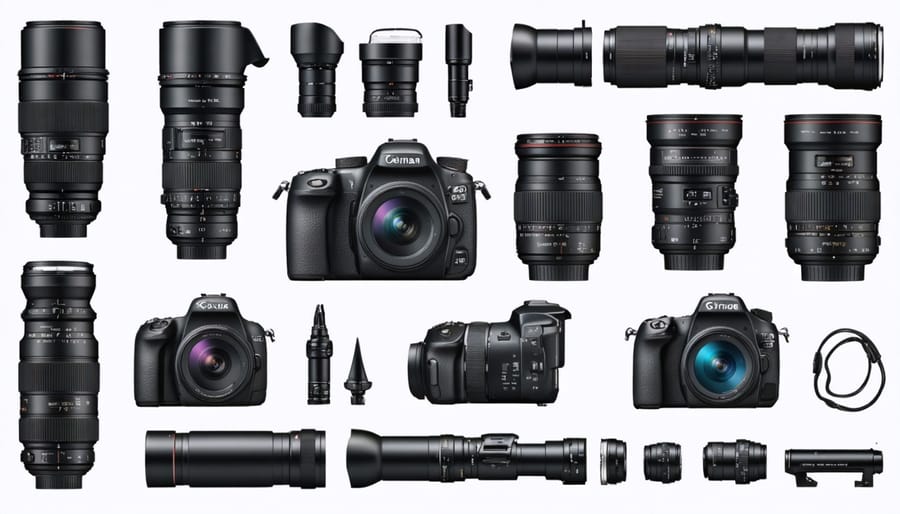
Proof of Value and Ownership
When filing an insurance claim, proper documentation is your best friend. Start by maintaining a detailed inventory of your photography equipment, including serial numbers, purchase dates, and original receipts. For those buying second-hand gear, documenting pre-owned equipment value requires additional steps, such as obtaining authentication certificates or professional appraisals.
Photograph each piece of equipment from multiple angles, paying special attention to any identifying marks or serial numbers. Store these images both digitally (cloud storage recommended) and in print format. Keep receipts organized by date and maintain digital copies – many insurance companies now accept digital documentation for claims.
For high-value items, consider getting professional appraisals every few years to ensure your coverage reflects current market values. Regular maintenance records and warranty information can also support your claims, especially for professional-grade equipment.
Create a spreadsheet or use a dedicated inventory app to track your gear’s details, including:
– Make and model
– Serial numbers
– Purchase price and date
– Current market value
– Condition notes
– Maintenance history
Update this inventory whenever you acquire new equipment or sell existing gear. Remember to keep backup copies of all documentation in a separate location from your equipment.
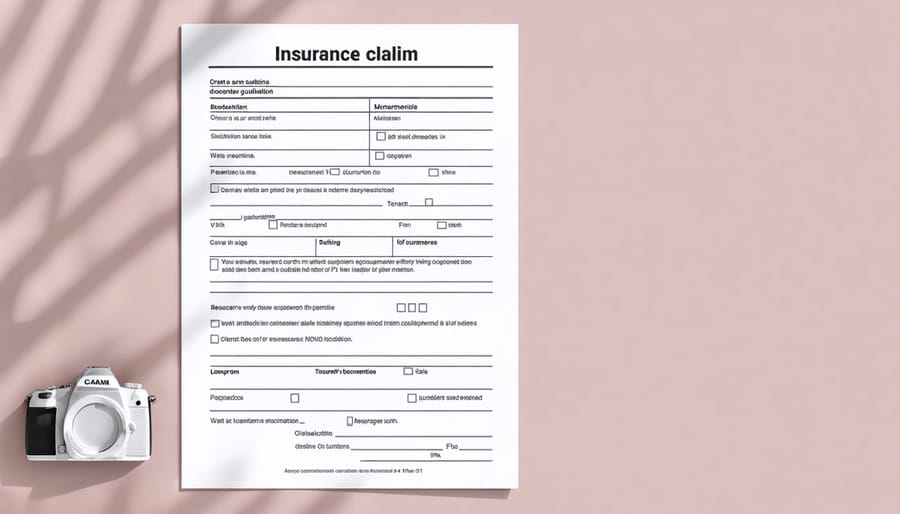
Filing a Claim: What You Need to Know
Filing an insurance claim for your photography equipment doesn’t have to be stressful if you’re well-prepared and know the process. Here’s what you need to do when the unexpected happens.
First, contact your insurance provider immediately after the incident. Most insurers have specific timeframes for claim submissions, typically within 24-48 hours. Document everything thoroughly – take photos of damaged equipment, gather witness statements if applicable, and file a police report for theft cases.
Keep all your original documentation handy. This includes:
– Original purchase receipts
– Serial numbers
– Recent appraisals
– Photos of your equipment (taken before the incident)
– Maintenance records
– Any relevant correspondence
When submitting your claim, be precise and honest about what happened. Provide a detailed account of the incident, including date, time, location, and circumstances. If you’re claiming for stolen equipment, include the police report number and officer’s contact information.
Pro tip: Many photographers create equipment inventory spreadsheets with photos and serial numbers before anything happens. This makes the claims process much smoother and helps ensure you don’t forget any items.
Most insurers now offer online claim submission portals, but it’s worth following up with a phone call to ensure everything’s received properly. Keep copies of all submitted documents and note down the claim number and any reference numbers provided.
Be prepared for questions from the claims adjuster. They might ask about the condition of the equipment, how it was stored, or whether it was being used professionally at the time of the incident. Answer truthfully and provide any additional documentation they request.
Remember that processing times vary by insurer and claim complexity. While some straightforward claims might be settled within days, others could take several weeks. Stay in regular contact with your claims representative and don’t hesitate to ask questions about the process or timeline.
Protecting your photography equipment is not just about safeguarding your gear – it’s about securing your passion, profession, and peace of mind. Throughout this guide, we’ve explored the various aspects of photo equipment insurance, from understanding basic coverage options to navigating specialized policies designed specifically for photographers.
Remember that the right insurance policy can make all the difference when unexpected situations arise. Whether you’re a professional photographer with extensive gear or an enthusiast with a growing collection, having proper insurance coverage ensures you can focus on creating amazing images without worrying about potential losses or damages.
Take time to evaluate your specific needs, document your equipment thoroughly, and compare different insurance options. Keep your inventory updated, maintain detailed records of purchases, and regularly review your policy to ensure it grows with your photography journey.
Don’t wait for an unfortunate incident to realize the importance of insurance. Take action today by assessing your current coverage and reaching out to insurance providers who understand the unique needs of photographers. The small investment in comprehensive coverage now can save you from significant financial stress in the future and keep you shooting with confidence.
By protecting your gear with the right insurance policy, you’re not just insuring equipment – you’re investing in the continuity of your photographic pursuits and protecting the tools that help bring your creative vision to life.
